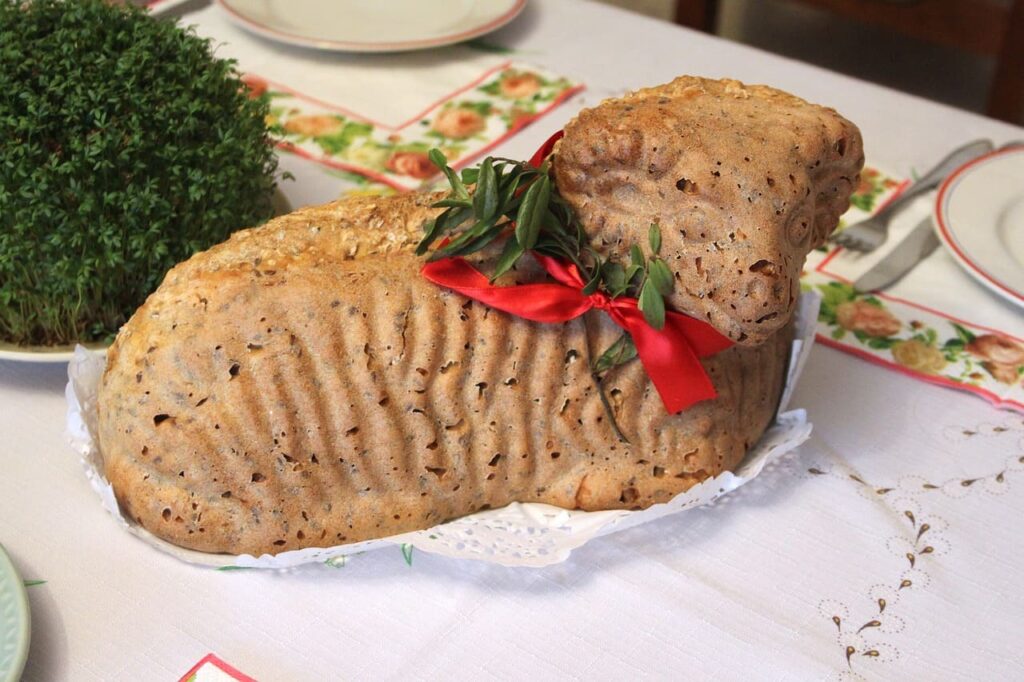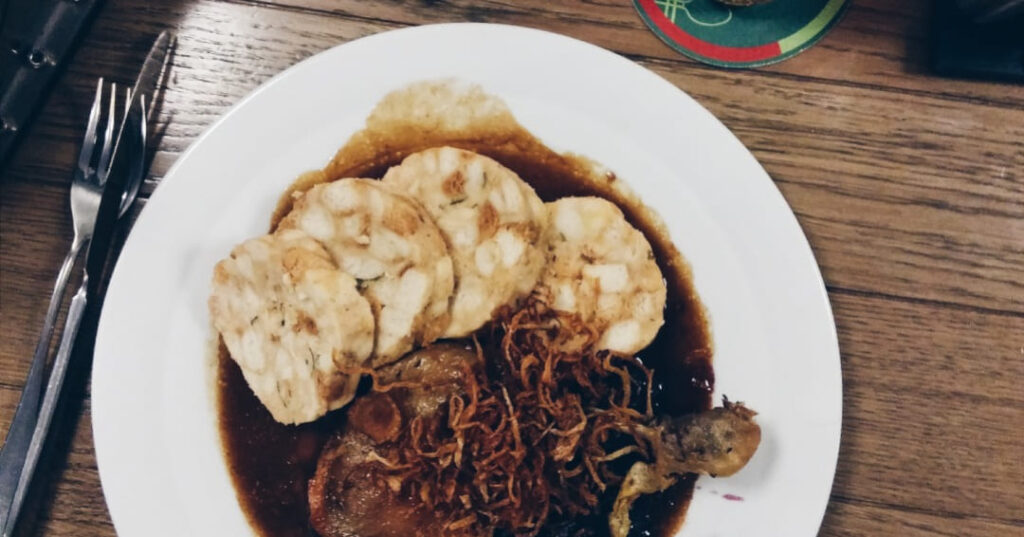To Czechs, Easter is a time of grand celebration. There are many Czech Easter food traditions to go along with all the good vibes. Traditional Czech Easter food often comprises a wide variety of foods prepared exclusively for the occasion.
Two opposites collide on Easter. It’s a moment for a feast following 40 days of fasting during Lent.
Many traditional Czech Easter foods are prepared and served in honor of the holiday. The Easter food provided in many countries varies greatly since each region celebrates the holiday uniquely. Czech Easter food traditions evolved from blending pagan and Christian beliefs.
Some of the most popular and delicious traditional Czech Easter food include Mazanec, beránek, and nádivka
Green Thursday marks the beginning of Easter festivities, where numerous pubs throughout the Czech republic serve green-coloured beer. Ugly Wednesday is spent cleaning as the Czechs prepare to usher in the Easter holy week. Read on for more information about traditional Czech Easter foods.
3 Best Traditional Czech Easter Food: Mazanec, Beránek, And Nádivka
The most traditional Easter food in the Czech Republic is lamb. Still, it’s not yet Easter without Mazanec, the Easter bread, Beránek, the lamb cake, And Nádivka, the Easter stuffings.
Mazanec (Easter bread)

You’ll get a traditional Czech Easter food: Czech Easter bread.
Mazanec is a type of sweet bread that is typically made with shredded almonds and raisins that have been steeped in rum. To symbolize Christ, it is circular, with a cross sitting on top. And it’s consumed all during the Holy Week.
Beránek (Lamb cake)

Several older Czechs celebrated Easter with just a cake in the form of a lamb because they couldn’t afford a real lamb.
The beránek is yet another well-known Czech Easter food. They’re delicious, and chocolate makes them even better. They are especially popular among youngsters.
Nádivka (Easter Stuffings)

Six different kinds of steak, mutton, rabbit, lamb, goat, and veal—were traditionally used to make the famous Czech Easter stuffing.
These recipes for this traditional easter food in the Czech republic include one similarity: they need spring herbs.
Czech Easter Food Traditions: Daily Dishes for the Holy Week
Ugly Wednesday
There are many dishes associated with the Easter holiday, including Kaiserschmarn prepared on Ugly Wednesday (because the meal is meant to be “ugly” rather than as planned).
Wednesday of Holy Week is known as Škaredá středa in the Czech Republic (“Ugly Wednesday”). “Spy Wednesday” is also another moniker for this day. This day’s title commemorates the very day Judas betrayed Christ.
Maundy Thursday
This day is also known as Green Thursday. Young boys traditionally roam the streets with clapperboards or other rattles. You can spice up the day by baking so-called “Judas rolls’ or Easter buns from sourdough.
This Czech Easter food is supposed to symbolize the rope on which Judas hung himself. According to tradition, the rolls are covered with honey and are best eaten before dawn. Doing that is supposed to guarantee good health and even protect against snake bites and insect stings.
Enjoy also something green on Green Thursday.
Good Friday
This day marks the end of Lent and is traditionally observed with a fast. You shouldn’t starve yourself but instead eat healthy, vegetarian meals. You can eat fish or creamy broth on Good Friday. If they couldn’t buy fish, poor folks used to make do by baking mashed potatoes shaped like fish.
On Good Friday, people traditionally ate a hearty sauerkraut and potato soup. The dinner also included spinach. You can go to the woods after enjoying the Czech easter traditional food. This is the day the earth supposedly reveals its riches and opens up to humanity.
Holy Saturday
Czech homes are filled with the delicious scent of stuffing baking in the oven on white Saturday.
Since Thanksgiving follows the close of Lent, the filling constitutes one of the most opulent Czech Easter food. Symbolic of spring, popular nettle is among the green herbs used in this dish, along with smoked meat and eggs.
You can also eat nádivka and the yummy Mazanec on “White Saturday.”
Easter Sunday
The most copious lunch of Easter in the Czech Republic is Easter Sunday.
In the past, families’ ability to make Czech Easter food was a significant factor when deciding how much they ate on this day; however, nowadays, nearly everybody eats meat. The delicious lamb cake, a representation of Jesus’s sacrifice, is an essential component of the feast alongside the roasted meat.
On Easter Sunday, after making Easter delicacies like buchty, jidáe, and puálky and serving meat soup with baked beef and sweetened beránek for dessert, the festivities come to a close.
Easter Monday
Easter Monday is traditionally the day young men in Moravia “whip” young women with pomlázkas.
The young lads will flog girls playfully all around the city in the mornings of Easter Monday, hoping to keep them healthier for the remainder of the calendar year. The lads use the eggs they obtain from the young women they date as a component in the mirgustovka. It’s a visually pleasing meal that also helps settle an upset stomach after a morning spent ushering spring outside.
Eggs also represent new beginnings and are included prominently in many Czech Easter food traditions.
Discover the Art of Czech Cuisine: Traditional Cooking Class in Prague
Immerse yourself in the flavors and techniques of Czech cuisine with our hands-on cooking class in Prague. Learn to prepare and savor traditional Czech meals, including iconic dishes like goulash, dumplings, and apple strudel. Join us for an unforgettable culinary experience that will bring the taste of Czech culture to your kitchen.
Highlights
- Master the art of cooking traditional Czech dishes, such as goulash, dumplings, and apple strudel, under the guidance of skilled chefs.
- Immerse yourself in Czech culinary traditions as you learn about the ingredients, techniques, and cultural significance behind each dish.
- Visit a local farmer’s market to explore the vibrant array of fresh, local ingredients used in Czech cooking and gain a deeper understanding of Czech cuisine.
- Create a mouthwatering 3-course meal that showcases the flavors and authenticity of Czech gastronomy.
- Take home recipes that you can use to recreate these delicious Czech meals and share the experience with family and friends.
Included
- High-quality cooking ingredients for the class, ensuring an authentic taste.
- Recipes that you can take with you, allowing you to continue practicing and perfecting your Czech cooking skills.
- Use of kitchen utensils and equipment, providing a professional cooking environment.
- Aprons for your convenience during the class.
- Enjoy the fruits of your labor as you indulge in a delectable 3-course meal prepared by you.
- Explore a local farmer’s market and witness the rich variety of Czech ingredients.
Savour the flavour of Czech Easter food!
If you’re planning a trip to the Czech Republic this Easter, you should know that the holiday is celebrated with a wide selection of the finest traditional Czech Easter food, such as bread, exquisite dumplings, miniature lambs, bread buns, eggs, and meats. Tasty and filling, these foods are a standard part of many people’s holiday gatherings.
If you are unfamiliar with Prague and want to learn more about what to see and do, our Czech expat guide will show you the way.






